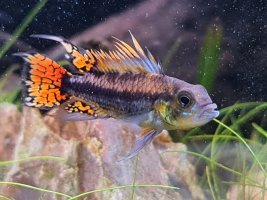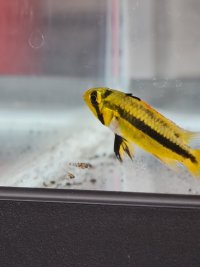sebcloud88
Seedling
My partner and I are having problems breeding our apistogramas, more specifically keeping the fry alive. For the sake of getting as much help as possible I will try to be as accurate as possible with what we've done.
We have 3 tanks in total all of them between 27/28c (1 for both mum and dad, a second little breeding trap that attaches to mum and dad's tank, and a third one to grow the fry on their own.
Once the female laid her eggs we put her little cave with the eggs and herself in it in the breeding trap. The eggs hatched, about 35, and the female started doing her job (only her second spawn, the first time she didn't know what to do and ate all the eggs !). With the dad in a separate tank we thought the job would be easy now !
We started feeding them tiny crunched up flakes and Daphnes but with hindsight maybe something smaller like micro worms would be better for the fry ? After about 5/6 days we noticed the female was eating one or two of the fry (not just moving them places like she also does) so we took her out and put her back with the male.
As there was still about 25 fry in that tiny little breeding trap we transferred them to the growing out tank and since (4 days later) we've only got about a handful left as the rest of the fry is dead. They are now about 2.5 weeks old and with only about 5 or 6 fry left not sure what has gone wrong.
Water parameters are the same for all 3 tanks (bacteria the same for all) temperature the same too.
If anyone has experience breeding successfuly double reds it would be highly appreciated if you could give us some tips or how you did it so we can have little baby apistos swimming around.
Quite sad and disheartening seeing them go one by one especially with the time and effort we have put into it.
We have 3 tanks in total all of them between 27/28c (1 for both mum and dad, a second little breeding trap that attaches to mum and dad's tank, and a third one to grow the fry on their own.
Once the female laid her eggs we put her little cave with the eggs and herself in it in the breeding trap. The eggs hatched, about 35, and the female started doing her job (only her second spawn, the first time she didn't know what to do and ate all the eggs !). With the dad in a separate tank we thought the job would be easy now !
We started feeding them tiny crunched up flakes and Daphnes but with hindsight maybe something smaller like micro worms would be better for the fry ? After about 5/6 days we noticed the female was eating one or two of the fry (not just moving them places like she also does) so we took her out and put her back with the male.
As there was still about 25 fry in that tiny little breeding trap we transferred them to the growing out tank and since (4 days later) we've only got about a handful left as the rest of the fry is dead. They are now about 2.5 weeks old and with only about 5 or 6 fry left not sure what has gone wrong.
Water parameters are the same for all 3 tanks (bacteria the same for all) temperature the same too.
If anyone has experience breeding successfuly double reds it would be highly appreciated if you could give us some tips or how you did it so we can have little baby apistos swimming around.
Quite sad and disheartening seeing them go one by one especially with the time and effort we have put into it.




